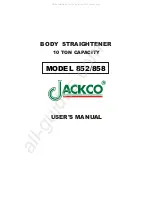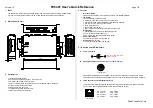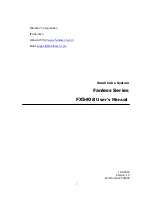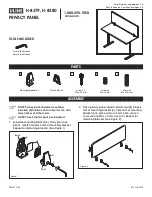
90
G20, 30, 40 SIIIA Operation & Maintenance Manual
If no steam or engine coolant can be seen or heard, open
the canopy or door. If the engine coolant is boiling, wait
until it stops before proceeding. The engine coolant level
should be between the “MAX COLD” and “MIN” marks on
the reserve tank.
Make sure the fan belt is not broken, or off the pulley, and
that the fan turns when the engine is started. If the engine
coolant level in the reserve tank is low, look for leaks at
the radiator hoses and connections, radiator, and water
pump. If you find major leaks, do not run the engine until
these problems have been corrected. If you do not find a
leak or other problem, WAIT UNTIL THE ENGINE HAS
COOLED DOWN then carefully add engine coolant to the
reserve tank.
(Engine coolant is a mixture of ethylene glycol antifreeze
and water. See “Engine Care in cold season” for the
proper antifreeze and mixture.)
WARNING
To avoid being burned, do not spill antifreeze or
engine coolant on the exhaust system or hot engine
parts. Under some conditions the ethylene glycol in
engine coolant is combustible.
If the engine coolant level in the reserve tank is at the
correct level but there is still an indication of an overheat
condition and no cause was found, please consult your
local branch or dealer.
Overcooling
Operating the engine at low coolant temperature will not
only increase the oil and fuel consumption but also will
lead to premature parts wear which may result in engine
failure. Ensure that the engine reaches normal operating
temperature 75 to 85°C (167 to 185°F) within ten minutes
of starting.
(3)
Hourmeter
- This meter indicates the machine
operation hours. Make sure that the meter is always
working during engine operation. Periodical machine
maintenance is scheduled on the operation hours
indicated on the hourmeter.
(4)
Liquid and Exhaust Smoke Leakage
- Make regular
checks for lubricant, fuel, coolant and exhaust smoke
leakage.
(5)
Abnormal Engine Noise
- In the event of any
abnormal engine noise, please consult your local
branch or dealer.
(6)
State of the Exhaust Smoke
- Check for any
abnormal exhaust smoke color.
COLD START DEVICE
WARNING
Sudden Movement Hazard!
•
Engaging the transmission or PTO at an elevated
engine speed could result in unexpected
movement of the equipment.
•
Failure to comply could result in death or serious
injury.
The cold start device on direct injection models improves
engine starting at lower temperatures.
•
If the engine cooling system temperature is below 5
°C (41 °F), the cold start device automatically
advances the fuel injection timing and slightly
increases the fuel injection volume.
•
The engine idle speed will be slightly elevated for
approximately the first 5 minutes of operation.
•
When the cold start device is activated, you may
notice a slight increase in the amount of exhaust
smoke. This is normal.
•
Never engage the transmission or PTO while the cold
start device is activated or unexpected movement of
the machine may result.
ENGINE STOPPING
(1) Close service valves.
(2) Before stopping the engine, cool down the engine by
operating it at reduced load about three minutes. In
this period, check the engine noise for abnormalities.
LONG TERM STORAGE
If the equipment is to be out of operation for an extended
period, it should be started at least once per week and
run on load for about 15 minutes after it has reached
normal operating temperature.
If this is not possible,
•
Do not drain the cooling water
•
Clean dust or oil from the engine extension
•
Either fill completely or drain the fuel tank
•
Grease accelerator joints and electrical connections
•
Disconnect the negative battery terminal
Summary of Contents for G20 SIIIA
Page 2: ......
Page 4: ...4 G20 30 40 SIIIA Operation Maintenance Manual ...
Page 10: ...10 G20 30 40 SIIIA Operation Maintenance Manual ...
Page 15: ...15 G20 30 40 SIIIA Operation Maintenance Manual WARNING Flammable liquid ...
Page 20: ...20 G20 30 40 SIIIA Operation Maintenance Manual ...
Page 121: ......
















































